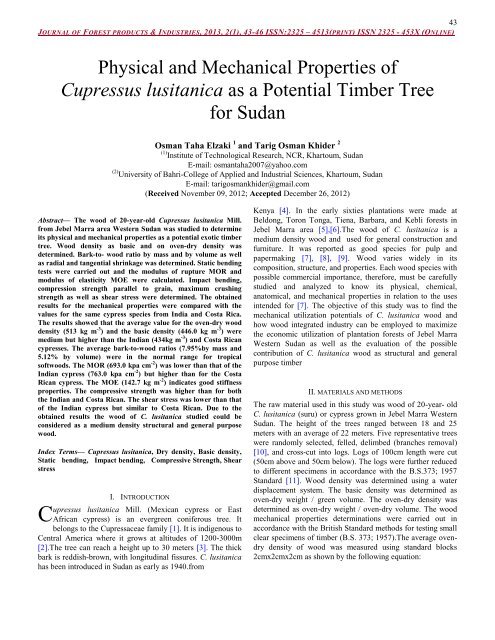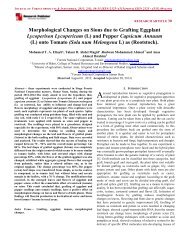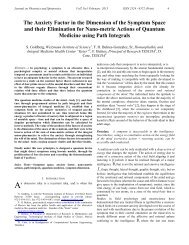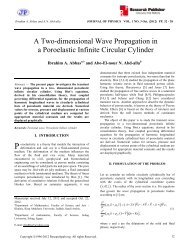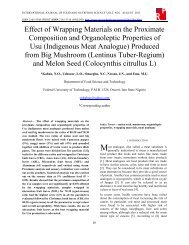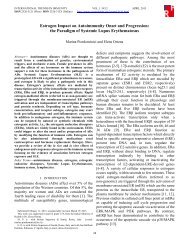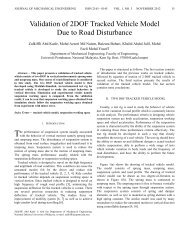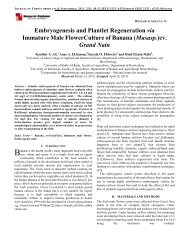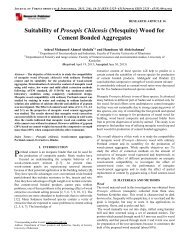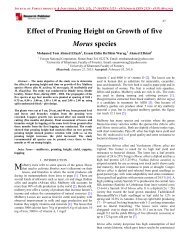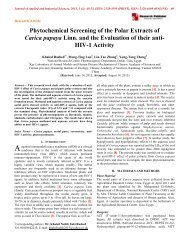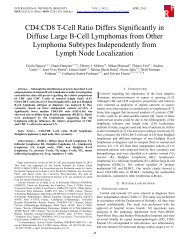Physical and Mechanical Properties of Cupressus lusitanica as a ...
Physical and Mechanical Properties of Cupressus lusitanica as a ...
Physical and Mechanical Properties of Cupressus lusitanica as a ...
You also want an ePaper? Increase the reach of your titles
YUMPU automatically turns print PDFs into web optimized ePapers that Google loves.
43<br />
JOURNAL OF FOREST PRODUCTS & INDUSTRIES, 2013, 2(1), 43-46 ISSN:2325 – 4513(PRINT) ISSN 2325 - 453X (ONLINE)<br />
<strong>Physical</strong> <strong>and</strong> <strong>Mechanical</strong> <strong>Properties</strong> <strong>of</strong><br />
<strong>Cupressus</strong> <strong>lusitanica</strong> <strong>as</strong> a Potential Timber Tree<br />
for Sudan<br />
Osman Taha Elzaki 1 <strong>and</strong> Tarig Osman Khider 2<br />
(1) Institute <strong>of</strong> Technological Research, NCR, Khartoum, Sudan<br />
E-mail: osmantaha2007@yahoo.com<br />
(2) University <strong>of</strong> Bahri-College <strong>of</strong> Applied <strong>and</strong> Industrial Sciences, Khartoum, Sudan<br />
E-mail: tarigosmankhider@gmail.com<br />
(Received November 09, 2012; Accepted December 26, 2012)<br />
<br />
Abstract— The wood <strong>of</strong> 20-year-old <strong>Cupressus</strong> <strong>lusitanica</strong> Mill.<br />
from Jebel Marra area Western Sudan w<strong>as</strong> studied to determine<br />
its physical <strong>and</strong> mechanical properties <strong>as</strong> a potential exotic timber<br />
tree. Wood density <strong>as</strong> b<strong>as</strong>ic <strong>and</strong> on oven-dry density w<strong>as</strong><br />
determined. Bark-to- wood ratio by m<strong>as</strong>s <strong>and</strong> by volume <strong>as</strong> well<br />
<strong>as</strong> radial <strong>and</strong> tangential shrinkage w<strong>as</strong> determined. Static bending<br />
tests were carried out <strong>and</strong> the modulus <strong>of</strong> rupture MOR <strong>and</strong><br />
modulus <strong>of</strong> el<strong>as</strong>ticity MOE were calculated. Impact bending,<br />
compression strength parallel to grain, maximum crushing<br />
strength <strong>as</strong> well <strong>as</strong> shear stress were determined. The obtained<br />
results for the mechanical properties were compared with the<br />
values for the same cypress species from India <strong>and</strong> Costa Rica.<br />
The results showed that the average value for the oven-dry wood<br />
density (513 kg m -3 ) <strong>and</strong> the b<strong>as</strong>ic density (446.0 kg m -3 ) were<br />
medium but higher than the Indian (434kg m -3 ) <strong>and</strong> Costa Rican<br />
cypresses. The average bark-to-wood ratios (7.95%by m<strong>as</strong>s <strong>and</strong><br />
5.12% by volume) were in the normal range for tropical<br />
s<strong>of</strong>twoods. The MOR (693.0 kpa cm -2 ) w<strong>as</strong> lower than that <strong>of</strong> the<br />
Indian cypress (763.0 kpa cm -2 ) but higher than for the Costa<br />
Rican cypress. The MOE (142.7 kg m -2 ) indicates good stiffness<br />
properties. The compressive strength w<strong>as</strong> higher than for both<br />
the Indian <strong>and</strong> Costa Rican. The shear stress w<strong>as</strong> lower than that<br />
<strong>of</strong> the Indian cypress but similar to Costa Rican. Due to the<br />
obtained results the wood <strong>of</strong> C. <strong>lusitanica</strong> studied could be<br />
considered <strong>as</strong> a medium density structural <strong>and</strong> general purpose<br />
wood.<br />
Index Terms— <strong>Cupressus</strong> <strong>lusitanica</strong>, Dry density, B<strong>as</strong>ic density,<br />
Static bending, Impact bending, Compressive Strength, Shear<br />
stress<br />
C<br />
I. INTRODUCTION<br />
upressus <strong>lusitanica</strong> Mill. (Mexican cypress or E<strong>as</strong>t<br />
African cypress) is an evergreen coniferous tree. It<br />
belongs to the Cupressaceae family [1]. It is indigenous to<br />
Central America where it grows at altitudes <strong>of</strong> 1200-3000m<br />
[2].The tree can reach a height up to 30 meters [3]. The thick<br />
bark is reddish-brown, with longitudinal fissures. C. <strong>lusitanica</strong><br />
h<strong>as</strong> been introduced in Sudan <strong>as</strong> early <strong>as</strong> 1940.from<br />
Kenya [4]. In the early sixties plantations were made at<br />
Beldong, Toron Tonga, Tiena, Barbara, <strong>and</strong> Kebli forests in<br />
Jebel Marra area [5],[6].The wood <strong>of</strong> C. <strong>lusitanica</strong> is a<br />
medium density wood <strong>and</strong> used for general construction <strong>and</strong><br />
furniture. It w<strong>as</strong> reported <strong>as</strong> good species for pulp <strong>and</strong><br />
papermaking [7], [8], [9]. Wood varies widely in its<br />
composition, structure, <strong>and</strong> properties. Each wood species with<br />
possible commercial importance, therefore, must be carefully<br />
studied <strong>and</strong> analyzed to know its physical, chemical,<br />
anatomical, <strong>and</strong> mechanical properties in relation to the uses<br />
intended for [7]. The objective <strong>of</strong> this study w<strong>as</strong> to find the<br />
mechanical utilization potentials <strong>of</strong> C. <strong>lusitanica</strong> wood <strong>and</strong><br />
how wood integrated industry can be employed to maximize<br />
the economic utilization <strong>of</strong> plantation forests <strong>of</strong> Jebel Marra<br />
Western Sudan <strong>as</strong> well <strong>as</strong> the evaluation <strong>of</strong> the possible<br />
contribution <strong>of</strong> C. <strong>lusitanica</strong> wood <strong>as</strong> structural <strong>and</strong> general<br />
purpose timber<br />
II. MATERIALS AND METHODS<br />
The raw material used in this study w<strong>as</strong> wood <strong>of</strong> 20-year- old<br />
C. <strong>lusitanica</strong> (suru) or cypress grown in Jebel Marra Western<br />
Sudan. The height <strong>of</strong> the trees ranged between 18 <strong>and</strong> 25<br />
meters with an average <strong>of</strong> 22 meters. Five representative trees<br />
were r<strong>and</strong>omly selected, felled, delimbed (branches removal)<br />
[10], <strong>and</strong> cross-cut into logs. Logs <strong>of</strong> 100cm length were cut<br />
(50cm above <strong>and</strong> 50cm below). The logs were further reduced<br />
to different specimens in accordance with the B.S.373; 1957<br />
St<strong>and</strong>ard [11]. Wood density w<strong>as</strong> determined using a water<br />
displacement system. The b<strong>as</strong>ic density w<strong>as</strong> determined <strong>as</strong><br />
oven-dry weight / green volume. The oven-dry density w<strong>as</strong><br />
determined <strong>as</strong> oven-dry weight / oven-dry volume. The wood<br />
mechanical properties determinations were carried out in<br />
accordance with the British St<strong>and</strong>ard methods for testing small<br />
clear specimens <strong>of</strong> timber (B.S. 373; 1957).The average ovendry<br />
density <strong>of</strong> wood w<strong>as</strong> me<strong>as</strong>ured using st<strong>and</strong>ard blocks<br />
2cmx2cmx2cm <strong>as</strong> shown by the following equation:
44<br />
JOURNAL OF FOREST PRODUCTS & INDUSTRIES, 2013, 2(1), 43-46 ISSN:2325 – 4513(PRINT) ISSN 2325 - 453X (ONLINE)<br />
Oven-dry Density = (kg m -2 ) [1]<br />
B<strong>as</strong>ic Density = (kg m -3 ) [2]<br />
Compression strength parallel to the grain w<strong>as</strong> carried out<br />
using specimens <strong>of</strong> 2cmx2cmx6cm. The test w<strong>as</strong> carried on a<br />
Losenhousenwerk universal testing machine. The maximum<br />
crushing strength (p max ) w<strong>as</strong> calculated by dividing the load to<br />
failure by the cross –sectional area <strong>of</strong> the specimen <strong>as</strong> shown<br />
by the following equation:<br />
Comp // grain = (kpa m -2 ) [3]<br />
P(wmax) = is the maximum load at<br />
Break point (kpa)<br />
A = the area <strong>of</strong> cross-section <strong>of</strong> specimen (cm 2 )<br />
For both static bending <strong>and</strong> impact bending determination the<br />
size <strong>of</strong> the test specimen w<strong>as</strong> 2x2x30cm.The test specimens<br />
were supported over a span <strong>of</strong> 28cm. on the roller bearings.<br />
The load w<strong>as</strong> applied to the center <strong>of</strong> the beam <strong>and</strong> the loading<br />
head w<strong>as</strong> descending at a constant speed <strong>of</strong> 0.01mm/second.<br />
The machine used for static bending test w<strong>as</strong> the Hounsfield<br />
tensometer while for impact bending a small Hutt-Turner<br />
machine w<strong>as</strong> used. The Modulus <strong>of</strong> rupture (MOR) <strong>and</strong> the<br />
modulus <strong>of</strong> el<strong>as</strong>ticity (MOE) were calculated <strong>as</strong> follows:<br />
MOR, kpa cm -2 = [4]<br />
MOE, kpa cm -2 = [5]<br />
Where,<br />
P = load in kg at the limit <strong>of</strong> proportionality,<br />
L = span <strong>of</strong> the test specimen in cm,<br />
h = depth <strong>of</strong> the test specimen in cm,<br />
b = width <strong>of</strong> the test specimen in cm,<br />
∆ = deflection at the limit <strong>of</strong> proportionality in cm.<br />
The shear stress parallel to the grain test w<strong>as</strong> carried on 2-cm<br />
cubes using the Hounsfield tensometer, Maintained at a<br />
constant rate <strong>of</strong> crosshead movement <strong>of</strong> 0.01mm/second. The<br />
radial <strong>and</strong> tangential apparent average shearing stresses were<br />
calculated <strong>as</strong> follows:<br />
A.A. S. S., kpa cm-2 = [6]<br />
Where:<br />
p = maximum load in kpa causing shear.<br />
b = width <strong>of</strong> the test specimen in cm.<br />
h = depth <strong>of</strong> the test specimen in cm.<br />
All test pieces were completely free from defects including<br />
knots, splits, wane, resin pockets, bark or cross grain. Any<br />
samples showing defects were rejected from the test. All test<br />
specimens were conditioned at 12% moisture content for all<br />
mechanical tests. The results obtained were compared with<br />
those <strong>of</strong> 20 to 30-year –old cypress wood from India <strong>and</strong> 10-<br />
year-old cypress wood from Costa Rica.<br />
III. RESULTS AND DISCUSSION<br />
The mean values for physical properties <strong>of</strong> C. <strong>lusitanica</strong> from<br />
Western Sudan, India (studied by Shukla [12]), <strong>and</strong> Costa Rica<br />
(studied by Moya [13]) are shown in Table 1. The average<br />
values for b<strong>as</strong>ic density <strong>of</strong> wood from the three different<br />
regions (446.0 kg m -3 , 434.0 kg m-3, <strong>and</strong> 430.0 kg m-3<br />
respectively) are nearer to each other <strong>and</strong> they are in the<br />
normal range for tropical s<strong>of</strong>twoods. The average b<strong>as</strong>ic<br />
density for the saturated wood specimens w<strong>as</strong> lower than the<br />
oven-dry density for the same wood species <strong>and</strong> that w<strong>as</strong> due<br />
to the bigger volume <strong>of</strong> specimens at the fiber saturation point.<br />
Since the wood density is a characteristic <strong>of</strong> wood that affects<br />
the properties <strong>of</strong> the manufactured products, it could be taken<br />
<strong>as</strong> a re<strong>as</strong>onably reliable indicator <strong>of</strong> the wood strength <strong>and</strong><br />
e<strong>as</strong>e <strong>of</strong> working. The average values <strong>of</strong> bark-to wood ratio for<br />
the Sudanese cypress both by m<strong>as</strong>s <strong>and</strong> by volume (7.95 <strong>and</strong><br />
5.12 respectively) were in the normal range for tropical<br />
s<strong>of</strong>twoods. The bark –to- wood ratio for the Sudanese cypress<br />
w<strong>as</strong> also nearer to that <strong>of</strong> the Costa Rican cypress while the<br />
tangential <strong>and</strong> volumetric shrinkage for the Costa Rican<br />
cypress were lower than for the Sudanese cypress. According<br />
to these physical properties, the Sudanese cypress wood could<br />
be cl<strong>as</strong>sified <strong>as</strong> a medium density pulpwood <strong>and</strong> structural<br />
timber with moderate strength properties.<br />
The mean values <strong>of</strong> strength properties are shown in Table 2.<br />
The average value for modulus <strong>of</strong> rupture (MOR) for the<br />
Sudanese cypress (693.0 kPa cm -2 ) w<strong>as</strong> lower than the Indian<br />
(763.0 kPa cm -2 ) [12] <strong>and</strong> higher than the Costa Rican (576.0<br />
kPa cm -2 ). The lower value for the Costa Rican [13] cypress<br />
shows the effect <strong>of</strong> age on the strength properties <strong>of</strong> wood. The<br />
modulus <strong>of</strong> el<strong>as</strong>ticity (MOE) for the Sudanese cypress w<strong>as</strong><br />
higher than the Indian cypress [12]. The MOR <strong>and</strong> the MOE<br />
are important parameters for the use <strong>of</strong> wood <strong>as</strong> a structural<br />
material. MOR is an indication <strong>of</strong> bending strength <strong>of</strong> a board<br />
or structural element <strong>and</strong> MOE is an indication <strong>of</strong> stiffness.<br />
The results showed that the MOR for the Sudanese cypress (<br />
776.00 kpa cm -2 ) w<strong>as</strong> higher than that for the Indian (763.00<br />
kpa cm -2 ) which means higher stiffness, <strong>and</strong> <strong>as</strong> it is expected<br />
the reverse w<strong>as</strong> true for the MOE (142.7 kpa cm -2 ) but w<strong>as</strong><br />
also higher than the Indian cypress which h<strong>as</strong> shown only 87.9<br />
kpa cm -2 . This indicates that both the e<strong>as</strong>e with which the<br />
wood can be bent <strong>and</strong> the percentage <strong>of</strong> strength it retains after<br />
bending are <strong>of</strong> medium range like other <strong>Cupressus</strong> species<br />
[14]. This also proves that the grater the stiffness the less the<br />
deflection <strong>of</strong> the beam under load [15]. The impact bending <strong>as</strong><br />
a me<strong>as</strong>ure for toughness <strong>of</strong> timber h<strong>as</strong> shown a re<strong>as</strong>onable<br />
average height <strong>of</strong> drop (79.00 cm) this is good at resistance to<br />
suddenly applied loads .
45<br />
JOURNAL OF FOREST PRODUCTS & INDUSTRIES, 2013, 2(1), 43-46 ISSN:2325 – 4513(PRINT) ISSN 2325 - 453X (ONLINE)<br />
This indicates good toughness which is important when<br />
considering the wood for sports equipment <strong>and</strong> h<strong>and</strong>les <strong>of</strong><br />
striking tools but the best <strong>and</strong> suitable use is for ro<strong>of</strong>ing <strong>and</strong><br />
flooring where moderate impact strength is very important.<br />
The results for compression strength parallel to grain were<br />
higher than that <strong>of</strong> the Indian cypress where the maximum<br />
crushing strength reached 477.00 kpa cm -2 with an average <strong>of</strong><br />
421.00 kpa cm -2 compared to 319.00 kpa cm -2 <strong>of</strong> that <strong>of</strong> Indian<br />
cypress (Table 3). This is good for poles, posts, <strong>and</strong> trusses.<br />
The radial <strong>and</strong> tangential shear stress (101.50 kpa cm -2 <strong>and</strong><br />
114.00 kpa cm -2 respectively) results were both lower than<br />
those <strong>of</strong> the Indian cypress <strong>and</strong> higher than those <strong>of</strong> Cost Rica<br />
(Table 4).<br />
Table 1<br />
<strong>Physical</strong> <strong>Properties</strong> <strong>of</strong> <strong>Cupressus</strong> <strong>lusitanica</strong> wood from Western Sudan, India, <strong>and</strong> Costa Rica.<br />
Origin<br />
<strong>Properties</strong><br />
Oven-dry density kg m -3 Sudan<br />
Mean<br />
513.00<br />
India<br />
Shukla [12]<br />
Mean<br />
-<br />
Costa Rica Moya<br />
[13]<br />
Mean<br />
-<br />
446.00<br />
434.00<br />
430.00<br />
B<strong>as</strong>ic density kg m -3 7.12<br />
Bark- to-wood ratio by m<strong>as</strong>s %<br />
Bark- to-wood ratio by volume %<br />
7.95<br />
5.12<br />
-<br />
-<br />
-<br />
Radial shrinkage %<br />
3.20<br />
-<br />
3.24<br />
Tangential shrinkage (T) %<br />
Volumetric shrinkage (R) %<br />
5.80<br />
8.20<br />
-<br />
-<br />
4.42<br />
7.29<br />
Ratio <strong>of</strong> shrinkage T/R<br />
1.81<br />
1.36<br />
Table 2<br />
Average b<strong>as</strong>ic density, static bending, <strong>and</strong> impact bending for C. <strong>lusitanica</strong> Wood from Western Sudan<br />
compared with the same species from India <strong>and</strong> Costa Rica.<br />
Origin<br />
Western Sudan<br />
India<br />
Shukla<br />
[12]<br />
Costa Rica<br />
Moya<br />
[13]<br />
<strong>Properties</strong><br />
Mean Minimum Maximum Mean Mean<br />
B<strong>as</strong>ic density kg m -3<br />
Static Bending<br />
Modulus <strong>of</strong> rupture, kPa<br />
446.0<br />
693.0<br />
414.0<br />
485.30<br />
478.0<br />
776.00<br />
434.0<br />
763.00<br />
430.0<br />
576.00<br />
cm -2<br />
Modulus <strong>of</strong> el<strong>as</strong>ticity, MPa 142.7 98.8 178.4 87.9 76.0<br />
cm -2<br />
Impact Bending<br />
Maximum height <strong>of</strong> drop, cm<br />
79.00<br />
73.70<br />
86.4<br />
-<br />
-<br />
Table 3<br />
Compression strength parallel to grain for Sudanese C <strong>lusitanica</strong> wood from Western Sudan<br />
compared with the same species from India <strong>and</strong> Costa Rica.<br />
Origin<br />
Western Sudan<br />
Mean minimum maximum<br />
India cypress<br />
Shukla [12]<br />
Costa Rica<br />
Moya [13]<br />
Maximum crushing stress,<br />
KPa cm -2<br />
421.00<br />
392.00<br />
477.00<br />
319.00<br />
143.00
46<br />
JOURNAL OF FOREST PRODUCTS & INDUSTRIES, 2013, 2(1), 43-46 ISSN:2325 – 4513(PRINT) ISSN 2325 - 453X (ONLINE)<br />
Table 4<br />
Shear stress for Sudanese cypress (C. <strong>lusitanica</strong> ) wood from Western Sudan compared with The Indian <strong>and</strong> Costa Rican<br />
cypresses.<br />
Origin<br />
Western Sudan<br />
Mean Minimum Maximum<br />
India<br />
Shukla [12]<br />
Costa Rica<br />
Moya [13]<br />
Radial, kPa cm -2 101.50 96.00 112.00<br />
108.00<br />
101.00<br />
Tangential, kPa cm -2 114.00 101.00 124.00<br />
119.00<br />
94.00<br />
IV. CONCLUSIONS<br />
From the obtained results <strong>and</strong> b<strong>as</strong>ed on the physical <strong>and</strong><br />
mechanical properties, cypress wood from Western Sudan<br />
could be considered <strong>as</strong> medium density exotic s<strong>of</strong>twood <strong>of</strong><br />
good strength properties mainly in the modulus <strong>of</strong> rupture <strong>and</strong><br />
compression parallel to grain. The test results proved that this<br />
Sudanese cypress h<strong>as</strong> medium to-tough durable, <strong>and</strong> good<br />
Quality wood compared with the same cypress from India <strong>and</strong><br />
Costa Rica. Therefore, it could be used in many applications<br />
such <strong>as</strong> building constructions in the form <strong>of</strong> trusses, beams,<br />
headers, <strong>and</strong> poles. The impact bending result showed that it is<br />
also suitable for ro<strong>of</strong>ing, flooring, where moderate impact<br />
strength is very important. Due to its medium density, the<br />
Sudanese cypress wood could be used for veneer production<br />
<strong>and</strong> decorative purposes.<br />
REFERENCES<br />
[1] Farjon, Aljos.1993. Nomenclature <strong>of</strong> the Mexican cypress or<br />
"cedar <strong>of</strong> Goa",<strong>Cupressus</strong> <strong>lusitanica</strong> Mill. (Cupressaceae). Taxon 42:<br />
81-84.<br />
[2] Gadek, P. A. Alpers, D.L. Heswood, M.M.Quinn, C.J. 2000.<br />
Relationships Within Cupressaceae family; a combined<br />
morphological <strong>and</strong> molecular approach. American Journal <strong>of</strong><br />
Botany. Volume 87: 1044 – 1057.<br />
[3] FAO, 1981. Forest Resources for Tropical Africa. Tropical Forest<br />
Resources Assessment. FAO, Rome.<br />
[4] Bailey, L. H., Bailey, E. Z. 1976. Hortus third: A concise<br />
dictionary <strong>of</strong> plants cultivated in the United States <strong>and</strong> Canada.<br />
Macmillan, New York.<br />
[5] Jackson, J. K. 1960. The Introduction <strong>of</strong> Exotic Trees into<br />
Sudan. Sudan Silva Volume 10: 14 – 30.<br />
[6] Elzaki, O. T. 1990. Utilization Potentialities <strong>of</strong> Some Exotic<br />
F<strong>as</strong>t -growing Wood Species Grown in Western Sudan. Sudan. Ph.D.<br />
thesis .University <strong>of</strong> Khartoum.<br />
[7] Khristova, P. Gabir, S. Taha, O. 1989 <strong>Physical</strong>, Morphological<br />
<strong>and</strong> Chemical <strong>Properties</strong> <strong>of</strong> Some Exotic F<strong>as</strong>t-growing Wood Species<br />
in Sudan. Cellulose Chemistry <strong>and</strong> Technology. Vol. 32 No.2 : 121 –<br />
129.<br />
[8] Lindstrom, H., Harris, P., Nakada, R. 2002. Methods for<br />
me<strong>as</strong>uring stiffness <strong>of</strong> young trees. European Journal <strong>of</strong> Wood <strong>and</strong><br />
Wood Products. Volume 60 No. 3, pp. 165-174.<br />
[9] Palmer ,E.R. Gibbs, J. A. , Ganguli, S. <strong>and</strong> Dutta, A. P. 1986<br />
Pulping Charactristics <strong>of</strong> <strong>Cupressus</strong> <strong>lusitanica</strong> <strong>and</strong> Podocarpus<br />
milanjanus grown in The Sudan. Report <strong>of</strong> TDRI 173. TDRI,<br />
London.<br />
[10] Elzaki, O. T. Otuk, S. <strong>and</strong> Khider, T. 2012 Sulfur-free pulping<br />
<strong>of</strong> Crateva adansnii from Sudan. Journal <strong>of</strong> Forest Products &<br />
Industries, vol.1 (1): 23 – 26.<br />
[11] B. S. 373 1957. The British St<strong>and</strong>ard Methods <strong>of</strong> Testing<br />
Small clear Specimens <strong>of</strong> Timber. British St<strong>and</strong>ards Institute,<br />
London.<br />
[12] Shukla, N. K. <strong>and</strong> Sangal, S. K. 1986. Preliminary studies on<br />
the strength properties <strong>of</strong> some exotic timbers. Indian Forester Vol.<br />
112 : 459 – 465.<br />
[13] Moya, R. <strong>and</strong> Munoz, F. 2010 <strong>Physical</strong> <strong>and</strong> mechanical<br />
properties eight f<strong>as</strong>t-growing Plantation species in Costa Rica.<br />
Journal <strong>of</strong> Tropical Science 22 (3): 317 – 328.<br />
[14] Bolza, E, <strong>and</strong> Keating, W. V. 1972.African Timbers, the<br />
properties, uses, <strong>and</strong> characteristics <strong>of</strong> 700 species. Industrial<br />
Research Organization. Building Research, Commonwealth<br />
Scientific <strong>and</strong> Industrial Research Organization, Melbourne.<br />
[15] Panshin, A. J. <strong>and</strong> C. de Zeeuw, 1980. Textbook <strong>of</strong> Wood<br />
Technology 4th ed. McGraw-Hill. New York. 722 pp


